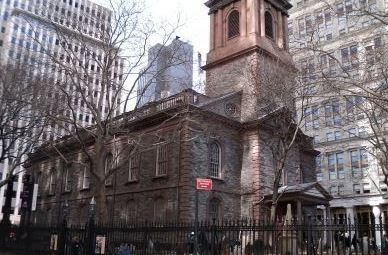Iwalkedaudiotours.com - The Episcopal church of St. Paul’s Chapel is the oldest surviving church in New York City. The initial chapel was constructed in 1766 as a chapel of ease for those individuals who lived north of the city and were unable to attend Trinity Church just a quarter of a mile to the south.
 |
| St. Paul’s Chapel |
St. Paul’s is the site, where on April 30, 1789, that George Washington attended service immediately after taking his oath of office at Federal Hall. While Trinity Church may seem like a more natural selection, Trinity was at the time a victim of the Great Fire of 1776 and in the process of being rebuilt. St. Paul’s had survived this devastation via a bucket brigade, which may provide some insight as to why it and not Trinity, is the oldest church in New York City. The pew where Washington sat in 1789 is now roped off along the northern wall for viewing if you visit the interior. This box has only been used once since this time when, in 1989, then President George H.W. Bush attended a mass here in honor of the bicentennial of establishment of the US presidency.
For its 200 plus years of existence St. Paul’s has largely maintained much of its original design. In 2007 it made perhaps one of its most significant changes, however, when it decided to remove all of the pews to create a more open space for worship.
Of course, St. Paul’s is also known for its close association and proximity to the events of 9/11. It has been described by many as “the little chapel that stood” for amazingly, through all of the dust and debris it did not suffer even a single broken window. During the subsequent clean-up efforts, St. Paul’s served as one of the major volunteer centers for which 14,000 people assisted. The iron perimeter fence during this time was also an often recorded site as family members posted pictures here searching for missing loved ones.
While walking around the yard at St. Paul’s take some time to admire the oak statue which resides just atop the Ionic columns on the front façade of the building. This statue is of St. Paul the apostle who is recognized as one of the primary authors of the New Testament. If you are doing this walk between the hours of midnight and 1a.m., then keep your eyes peeled to see if this statue comes alive. Various legends and tales have arisen over the years telling of how this statue would leave its perch and either come to greet onlookers or else make its way to a nearby water pump and refresh its parched wooden pallet.
From the rear of the chapel direct your attention to the center window. This is the back side of the alterpiece titled “Glory” which was designed by the same man who created the layout of Washington D.C., Pierre L’Enfant. While you may obviously get a better view from the inside of the chapel it is interesting to note from the backside that you can see the thirteen rays of light (representing the then thirteen colonies) emitting from the sun of the sculpture.
Also right within this vicinity (behind the chapel) is a large bell known as the Bell of Hope. It was presented to St. Paul’s by the Lord Mayor of London in September 2002. The bell was cast at the oldest manufacturing company in all of England, and the same foundry which cast the 13.5 ton bell for Big Ben in 1858 and the Liberty Bell in 1752, the Whitechapel Bell Foundry. Every year on September 11, the bell is rung.
If you want to spend a bit more time to take in the interiors of St. Paul’s Chapel feel free to do so. Admission is free and it is open 10am-6pm Mon-Fri, 10am-4pm Saturdays and 7am-4pm Sundays.
- Website: http://www.trinitywallstreet.org/congregation/spc/
- Address: 209 Broadway, New York City
- Cost: Free.
- Hours: Mon-Fri 10am-6pm; 10am-4pm Sat; 7am-4pm Sun
